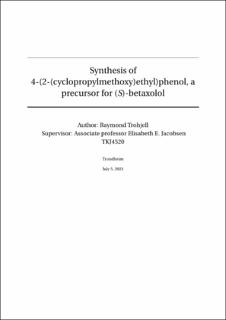| dc.contributor.advisor | Jacobsen, Elisabeth Egholm | |
| dc.contributor.author | Trohjell, Raymond | |
| dc.date.accessioned | 2021-09-28T18:32:02Z | |
| dc.date.available | 2021-09-28T18:32:02Z | |
| dc.date.issued | 2021 | |
| dc.identifier | no.ntnu:inspera:77798797:22054208 | |
| dc.identifier.uri | https://hdl.handle.net/11250/2785505 | |
| dc.description.abstract | Enantiomert rene legemidler blir dannet mer og mer fremfor rasemiske legemidler. (S)-betaksolol (S-1) er en β-blokker som har vist stort potensiale i behandling av glaukom. Det er blitt vist at (S)-enantiomeren av betaksolol er mye mer aktiv enn (R)-enantiomeren i behandlingen av glaukom.
Denne masteroppgaven siktet på å finne en syntese for å danne 4-(2-syklopropylmetoksyetyl)fenol (6), som er en byggestein for (S)-betaksolol og deretter å syntetisere betaksolol ved en enzym katalysert kinetisk oppløsning. Fra det kommersielt tilgjengelige 2-(4-hydroksyfenyl)etanol (2) ble addisjon av bensylbromid utført for å danne 2-(4-bensyloksyfenyl)etanol (3) i utbytte på 90,3 % (1,42 g, 6,22 mmol) (Skjema 1).
Fra den beskyttede alkoholen 3 ble det utført en syntese for å danne både 1-(2-allyloksy)etyl-4-(bensyloksy)benzen (4) og 1-bensyloksy-4-(2-syklopropylmetoksyetyl)benzen (5) utført. Syntese av 5 ved addisjon av (bromometyl)syklopropan oppnådde omsetning på 40 % av 3 til 5 etter 48 t ved 60 °C (Skjema 2).
Syntese av 1-(2-allyloksy)etyl-4-(bensyloksy)benzen (4) ble utført ved addisjon av allylbromid til 3 istedet for addisjon av (bromometyl)syklopropan (Skjema 3). Allyl 4 ble dannet i utbytte på 86,6 % (1,1347 g, 4,23 mmol)
En annen mulig rute for å danne betaksolol byggesteinen 6 var ved syntese av 4-(2-kloretyl)fenol (9) ved bruk av konsentrert saltsyre på 2 ved 100 °C (Skjema 4). Phenol 9 ble dannet i utbytte på 79,3 % (0,45 g, 2,87 mmol). Tilsats av Syklopropylmetanol ble brukt for å danne 6 fra fenol 9 (Skjema 5). Fenol 6 ble ikke isolert og renset i denne oppgaven.
Etter å ha dannet fenol 6, vil behandling med epiklorhydrin og katalytisk mengde base danne 1-klor-3-(4-(2-(syklopropylmetoksy)etyl)fenoksy)propan2-ol (7) (Skjema 6). Omsetning på 40 % av 6 til 7 ble oppnådd i denne oppgaven, men problemer med opparbeidelse av produkt hindret beregning av utbytte.
Et biprodukt fra syntesen av 7 er 2-(4-(2-(syklopropylmetoksy)etyl)fenoksy)metyloksiran (8). Epoksidet kan bli fjernet ved tilsats av LiCl og eddiksyre. Mekanisme for dannelse av epiklorhydrin 7 og epoksid 8 er vist i Skjema 2.9.
Etter at rasemisk klorhydrin 7 er dannet, vil kinetisk oppløsning
katalysert av Candida antarctica Lipase B danne (R)-7 og (S)-1-klor-3-(4-
(2-(syklopropylmetoksy)etyl)fenoksy)propan-2-yl butyrat ((S)-7b) (Skjema 7). | |
| dc.description.abstract | Enantiomerically pure drugs are synthesised and used instead of racemic mixtures. (S)-betaxolol ((S)-1) is one β-blocker that has shown promise in treatment of glaucoma and it has been shown that the (S)-enantiomer of
betaxolol is more potent than the (R)-enantiomer in treatment of glaucoma.
This master thesis aimed to find a synthetic route to 4-(2-cyclopropylmethoxyethyl)phenol (6), a (S)-betaxolol precursor and to synthesise betaxolol by enzyme catalysed kinetic resolution. Starting from
the commercially available 2-(4-hydroxyphenyl)ethanol (2), addition of benzylbromide was performed to form 2-(4-benzyloxyphenyl) ethanol (3) with a yield of 90,3 % (1,42 g, 6,22 mmol) (Scheme 1).
From the protected alcohol 3, synthesis to form both 1-(2-(allyloxy) ethyl4-(benzyloxy)benzene (4) and 1-benzyloxy-4-(2-cyclopropylmethoxyethyl)benzene (5) was performed. Synthesis of 5 by addition of (bromomethyl)cyclopropane was achieved in 40 % conversion of 3 into 5 after 48 h at 60 °C, but the product was not purified (Scheme 2).
Synthesis of 1-(2-(allyloxy) ethyl-4-(benzyloxy)benzene (4) was performed by addition of allylbromide to 3 instead of using (bromomethyl)cyclopropane (Scheme 3). Allyl 4 was obtained in 86,8 % yield (1,1347 g, 4,23 mmol).
Another potential path to synthesise betaxolol phenol 6 involves synthesis of 4-(2-chloroethyl)phenol 9 by treatment of 2 with concentrated HCl at 100 °C (Scheme 4). Phenol 9 Was obtained in 79,3 % yield (0,45 g, 2,87 mmol). To obtain 6, the phenol 9 can be treated with cyclopropylmethanol
(Scheme 5). Phenol 6 was not isolated and purified in this thesis. For the synthesis of betaxolol after having obtained 4-(2-cyclopropylmethoxyethyl)phenol (6) treatment with epichlorohydrin and catalytic amounts of base yields 1-chloro-3-(4-(2-(cyclopropylmethoxy)ethyl)phenoxy)propan-2-ol (7) (Scheme 6). 7 was obtained in conversion of 40 %, but difficulties in purification hindered the calculation of yield.
One byproduct from the synthesis of 7 is 2-(4-(2-(cyclopropylmethoxy)ethyl)phenoxy)methyloxirane (8). Epoxide 8 can be removed with treatment LiCl and acetic acid. The mechanism for formation of epoxide 8 and chlorohydrin 7 can be seen in Scheme 2.9.
Kinetic resolution of 7 catalysed by Candida antarctica Lipase B (CALB) will yield (R)-7 and (S)-1-chloro-3-(4-(2-(cyclopropylmethoxy)ethyl)phenoxy)propan-2-yl butyrate (S)-7b which can be used in the synthesis of (S)-betaxolol (Scheme 7). | |
| dc.language | eng | |
| dc.publisher | NTNU | |
| dc.title | Synthesis of 4-(2-(cyclopropylmethoxy)ethyl)phenol, a precursor for S-betaxolol | |
| dc.type | Master thesis | |
